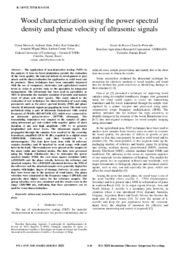Wood characterization using the power spectral density and phase velocity of ultrasonic signals.
Wood characterization using the power spectral density and phase velocity of ultrasonic signals.
Author(s): PENTEADO, S. do R. C.
Summary: The application of non-destructive testing (NDT) in the analysis of trees in forest plantations permits the evaluation of the wood quality, the internal defects in development or pest attack and its characterization for application as solid wood and its products. These techniques have been constantly improved with the use of computers, electronics and agricultural control levels in order to provide tools to the specialists in integrated management. The ultrasound has been used in agriculture as NDT to determine the elasticity modulus of juvenile and mature wood of pinus and other species. This study aimed to the evaluation of new techniques for characterization of wood using parameters such as the power spectral density (PSD) and phase velocity of ultrasonic signals propagating in wood. The tests were performed using a pair of ultrasonic transducers with central frequency of 50 kHz (083-067-038, GE) which were connected to an ultrasonic pulser/receiver (5077PR, Olympus). The transmitting transducer was coupled to the samples of pinus using ultrasound gel and excited with negative pulses of short duration (5 μs) and high amplitude (-400 V) to generate longitudinal and shear waves. The ultrasound signals that propagated through the samples were received by the receiving transducer, amplified (20 to 40 dB), acquired in a digital scope (MSO4104B, Tektronix) and then transferred to a microcomputer. The tests have been done with 10 reference samples (healthy) and 10 attacked by wood wasps, with small holes in the bark. The transducers were placed on the samples in the axial, radial and inclined modes. The data were processed using the Matlab (Mathworks Inc.) to determine the power spectral density (PSD), the root mean square deviation index (cRMSDdB) and the phase velocity between the reference and attacked samples. The cRMSDdB calculated between the PSD of the reference and the attacked samples were generally higher for samples with higher degree of damage, however, in some cases, they were lower due to the presence of wood knots. The phase velocities were calculated in the frequency range 1-200 kHz and generally show higher values for the reference samples. The group velocities were also calculated and the results were in the range 1200-3000 m/s, indicating that these parameters can be used for wood characterization.
Publication year: 2014
Types of publication: Paper in annals and proceedings
Unit: Embrapa Forestry
Observation
Some of Embrapa's publications are published as ePub files. To read them, use or download one of the following free software options to your computer or mobile device. Android: Google Play Books; IOS: iBooks; Windows and Linux: Calibre.
Access other publications
Access the Agricultural Research Database (BDPA) to consult Embrapa's full library collection and records.
Visit Embrapa Bookstore to purchase books and other publications sold by Embrapa.

